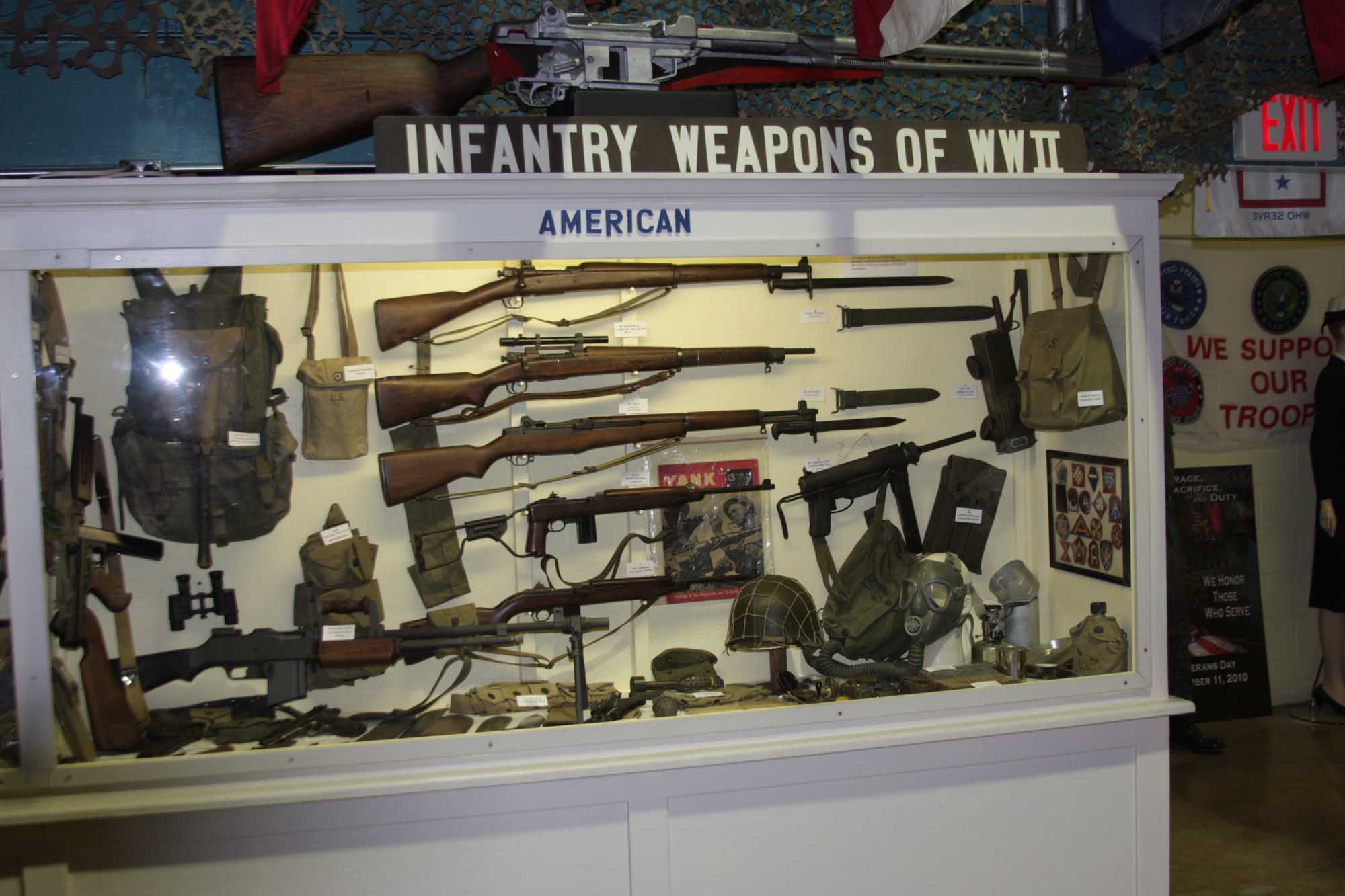M1 Garand:
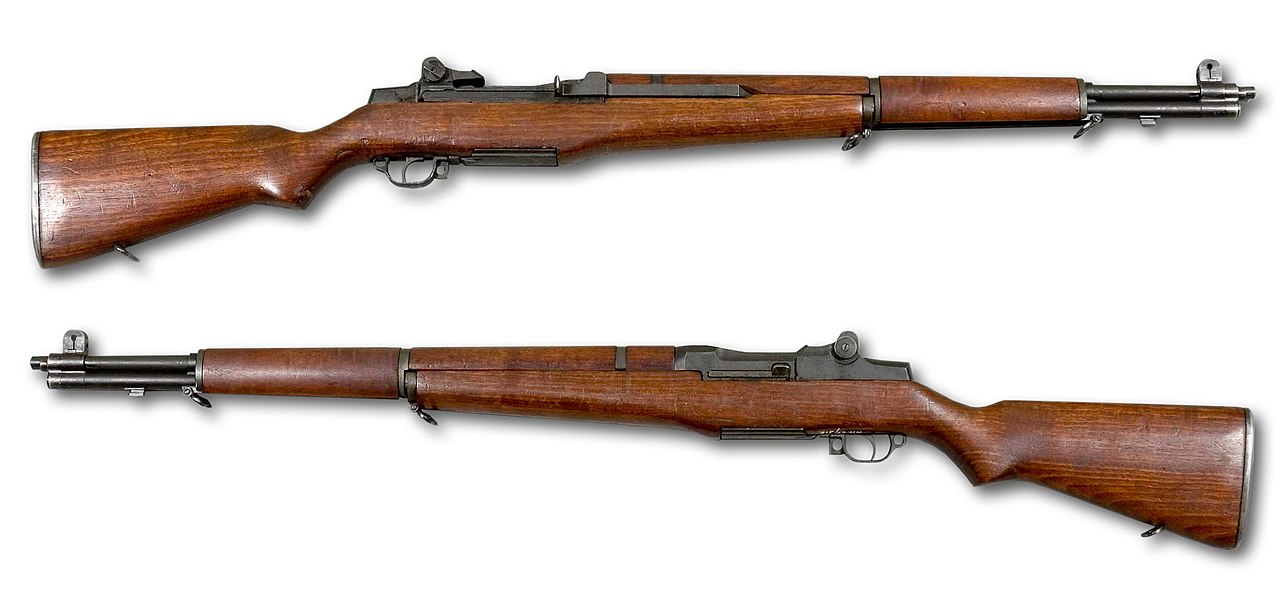
The M1 Garand is a gas operated semi-automatic rifle. The M1 Garand was designed for simple assembly and disassembly to facilitate field maintenance. It can be field stripped without tools in just a few seconds. The M1 was the standard main battle rifle issued to US troops during World War Two and the Korean War. The M1 rifle was named after its Canadian-American designer, John Garand. General George S. Patton famously called it "the greatest battle implement ever devised". The Garand replaced the 1903 Springfield bolt action rifle as the main battle rifle for the US Military in 1936. The Garand was later replaced by the .308 caliber M14. Basic design of the rifle began in 1924. After trials and several refinements, the rifle entered full production in 1936. The earliest model produced was the "gas trap" version which proved unsatisfactory and resulted in a redesign. About 5.4 million Garand rifles were made during World War Two. They were used by every branch of the US military. The M1 Garand was a significant improvement over the bolt action Springfield 1903 rifle and provided a very accurate high rate of fire. The Garand was fed by an eight round internal magazine which is loaded by inserting a loaded "clip". The clip is a linear metal strip which holds the rounds in place unlike a magazine which contains the cartridges inside. When the last round was fired, the rifle ejected the clip with a distinctive "ping" and held open the bolt. The .30-06 cartridge fired by the Garand has good ballistic characteristics and was effective at ranges over 500 yards. Size, weight and the limited capacity of the internal magazine were the principal shortcomings of this otherwise effective weapon. Other versions of the Garand were produced including a shorter "tanker" variant and a sniper rifle.
M1 Paratrooper Carbine:

The M1 Paratrooper Carbine is,except for the stock, essentially identical to the standard version of the M1. The Inland Division of General Motors manufactured 140,000 of the paratroop version. They were originally issued to the 82nd and 101st Airborne divisions but were later issued to all U.S. Army airborne units and the U.S. Marine Corps. The stock is not locked in the open or closed position, but is instead held in place by a spring-loaded cam. The buttstock is made of thick, steel wire.
Browning Automatic Rifle BAR:

The Browning BAR is a fully automatic infantry rifle smaller than a full sized machine gun, but larger than an assault rifle. Highly esteemed, the BAR was favored for its very effective firepower at great range. The M1918 BAR is a selective-fire, air-cooled automatic rifle using a gas-operated, long-stroke piston rod actuated by propellant gases. The rifle fires from an open bolt. The M1918 feeds using double-column 20-round box magazines. Originally, the rifles were fitted with black walnut butt stocks and grips which were later replaced by a black plastic butt stock composed of a mixture of Bakelite and Resinox, and impregnated with shredded fabric. The rifle was developed by weapons designer John Browning in 1917 and fired the standard .30-06 cartridge. Prototypes were built and the design was mature enough to enter production and deployment at the final years of WW1. The BAR was developed to replace the French-made Chauchat and M1909 Benét–Mercié machine guns previously used by US military forces. The BAR was designed to provide the infantry with a source of automatic fire that could be carried into battle since heavy machine guns, because of their weight, were operated from stationary positions. The BAR gave the infantry the ability to produce what was known as "walking fire" where the operator fired the weapon while advancing against the enemy with the rifle either being supported by a sling, or fired from the hip. The BAR became standard issue to US troops in 1938 and was classified as a light portable machinegun. However, the BAR is very heavy and bulky. Infantry armed with the BAR had to carry the weapon and perhaps 10 loaded magazines in addition to their own field gear. The BAR saw extensive use in WW2 and the Korean War and was eventually replaced by the venerable M60 machinegun in 1957.
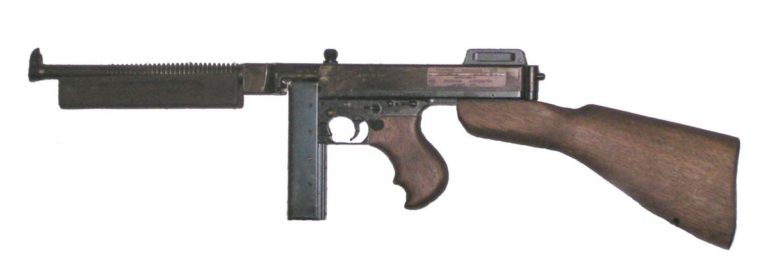
The Thompson submachine gun is an American submachine gun first invented by John T. Thompson in 1918. The Thompson has been highly favored for its compactness, and capability to produce a high rate fire. The Thompson is a very iconic weapon and has legendary popularity among law enforcement, military, civilians and criminals. The Thompson submachine gun was developed by General John T Thompson in Cleveland, Ohio. Thompson stated that his design concept was to produce a "one-man, hand-held machine gun" in .45 ACP as a "trench broom" for use in the ongoing trench warfare of World War I. The BAR was also intended to fulfill this role but was less effective as a "trench broom" because of its size and weight. The Thompson was the first firearm to be officially designated as a "submachine gun". First sales of the Thompson were to the United States Postal Inspection Service to protect the mail from robberies, and to the United States Marine Corps. The Thompson was adopted by the US Military in 1938 and served prominently in World War Two and beyond. 1.5 million were produced during World War Two. The Thompson could utilize both 20 and 30 round box magazines and 50 and 100 round drum type magazines. The drum magazines offered high capacity but were slow to reload and ammunition could move slightly inside the drum and generate undesirable sound. The box magazines were considered more practical. The Thompson was widely utilized by British and Canadian commando units as well as US Army Ranger and Paratrooper battalions where close combat was frequent. The Thompson was highly favored for its firepower, but disliked for its weight and reports of its unreliability. The .45 ACP had a limited effective range and limited penetration especially in dense jungle. The Thompson was eventually replaced by the M3 "Grease Gun" .
1911 Pistol:

The M1911 Colt Government pistol is a single-action, semi-automatic, magazine-fed, recoil-operated pistol. It is chambered for the .45 ACP cartridge. It was the standard issue sidearm for U.S. Military Armed Forces from 1911 through 1986. It was widely used in all major wars and conflicts during this time. About 2.7 million were procured for the US military during its service life. It was later replaced by the Beretta M9 pistol, although modern variants are still being used by some U.S. military organizations. The M1911 uses the short recoil system which is widely popular and incorporated in nearly all modern centerfire pistols.
M3 Greasegun:
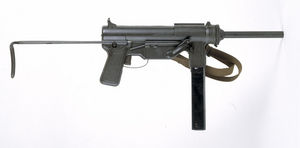
The M3 submachinegun was intended to replace the Thompson submachine gun and was adopted by the US Army in 1942. Like the Thompson, the M3 was chambered for the .45 ACP round and was intended to provide US forces with a weapon comparable to the German MP40 and the British STEN. Unlike the Thompson, the M3 was designed for cheap manufacture and was intended to be disposable when damaged or excessively used, and they were susceptible to damage. An impact to the side of the receiver could cause a dent which could impinge the free movement of the bolt, which would render the weapon useless. The M3 was manufactured mostly from stamped sheet steel using spot and seam welding methods and replacement parts were generally not provided to ordinance depots. Only the barrel, bolt and firing mechanism required machining. The M3 fires open-bolt and has a relatively slow cyclic rate of 450 rounds per minute. Also, like the Thompson, the M3 has a limited effective range of about 100 yards. Several problems were corrected in redesigns but the weapon was not fully matured until the Korean War and Vietnam. The M3 was withdrawn from frontline service in the early 1960's, but retains some popularity because of its small size and portability. The M3 utilizes 30 round box magazines.
1903 Springfield:

The 1903 Springfield rifle is a five round, magazine fed bolt-action repeating rifle. The rifle was primarily used during the first half of the 20th century. It was officially adopted by the United States Military in 1903 and saw service in WW1. It remained in service as a sniper rifle during WW2 and into the Korean war. The rifle was designed to overcome shortcomings of the Springfield Model 1892–99 Krag–Jørgensen bolt-action rifles and older single-shot Springfield rifles. Design concepts from the Spanish Mauser Model 1893 rifle captured during the Spanish–American War, the U.S. Krag rifle and the Mauser Model 93 were incorporated into the development of the M1903. The rifle fires the .30-06 Springfield round used in many rifles and machine guns, which is still a popular civilian cartridge to the present day. By the beginning of WW1, 843,239 of these rifles had been produced at Springfield Armory and Rock Island Arsenal. The M1903 was widely regarded for its accuracy and reliability. However the rifle was known for some drawbacks. The precision rear aperture sight was located too far from the eye for efficient use, and the narrow, unprotected front sight was difficult to see in poor light and easily damaged. A hood was later added by the U.S. Marine Corps to protect the front sight.
M1903 Sniper Rifle:
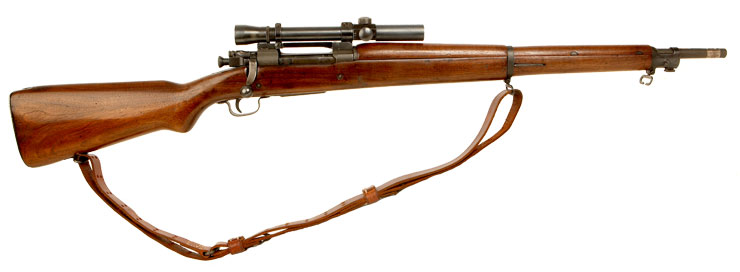
The M1903 A4 was the U.S. Army's sniper rifle of choice during the Second World War. This was a variant of the M1903 A3. The M1903 A4 used a Weaver Model 330 or 330C 2.75x telescopic sight scope mounted in place of the rear peep sight. During production, receivers were specifically tested so the best could be used in building the sniper version. The barrels were also specially selected. Front sights were not installed on the A4 barrels. The M1903 A4 was relatively accurate and had an effective range of about 600 yards. The primary deficiency was the limited field of view present in both the M73 and M73B1 scopes used by the A4.
Gas Trap Garand:

Included in the American Weapons of World War Two Display is an early model Garand rifle known as the "Gas Trap" Garand. This was the first version of the Garand rifle. About 50,000 of the estimated six million Garand rifles produced were of this Gas Trap configuration. In this design, the rifle utilized a "false muzzle" to redirect propellant gasses into the gas cylinder to operate the recoil system. The false muzzle at the end of the barrel is clearly distinguishable. Design flaws immediately became obvious. The mechanism was complicated to clean, the front sight was unstable, and the bayonet mount was structurally unsound. A new design for the Garand was quickly implemented which reflects the design of more modern rifles in which a port is drilled in the barrel to allow venting of gases into the gas cylinder. Production of the gas trap design was halted and existing rifles in production were modified to incorporate the new design. The vast majority of Garand rifles have the newer design. The early gas trap rifles are exceedingly rare.
M1 Carbine:
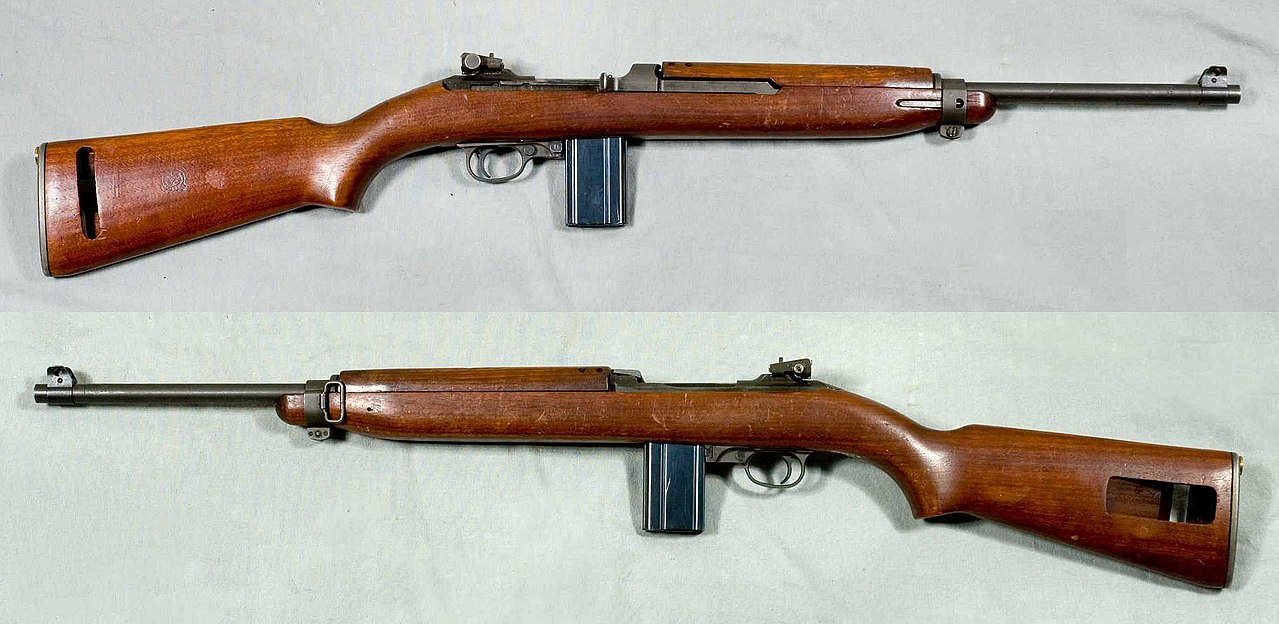
The M1 Carbine is a lightweight semi-automatic carbine rifle. It was a standard weapon issued to US troops during World War Two, and the Korean War. The M1 Carbine was also still used well into the Vietnam War. The M1 Carbine is not a carbine version of the Garand rifle. The design of the two rifles is different and they fire different cartridges. The M1 Carbine was developed to provide troops with a lightweight and compact defensive weapon more powerful and with greater range than pistols. They were also intended to be issued to paratroops. The rifle originated as a design by Jonathan "Ed" Browning, brother of the famous firearm designer John Browning. However, it was later re-engineered by designers from Winchester and the final configuration was approved in October 1941. The M1 Carbine fires a .30 caliber rimless cartridge much less powerful than the .30-06 ammunition fired by the M1 Garand, but more powerful than the .45 ACP round utilized by the Thompson submachine gun. It is interesting to note that the M1 Carbine did not fit neatly into the categorization of other military weapons of the time. It was larger and more powerful than a submachine gun, but too small to be considered a battle rifle. It has been compared to other weapons such as the STG44 and the AK 47 Kalishnikov, however, the M1 carbine is certainly outclassed by both. The enduring classification for the M1 is "Defensive Weapon". The M1 was commonly issued to artillery crews and support personnel. Frontline troops and paratroops did also receive the M1 carbine, however its reputation as a primary battle rifle is questionable. Range and stopping power were both limited with the M1. It was reported to have poor penetration when used against enemy troops with heavy winter clothing and field gear. The first M1 Carbines were issued with straight 15 round magazines. When the select fire version of the rifle was developed, curved 30 round magazines were developed. The M1 Carbine was the most produced weapon of the US Military. Over 6 million were made.



